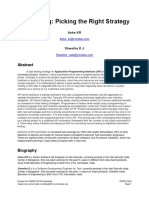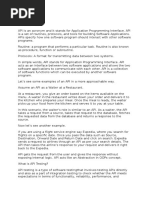API Testing Approach
Uploaded by
Saravanan MuruganAPI Testing Approach
Uploaded by
Saravanan MuruganAPI Testing Approach
Testing for APIs is similar to testing any other software, except that you need to think a bit more
technically. Unlike GUI based systems, there are no text fields or buttons which you can test,
you have to essentially hit the backend calls that are made when a user would perform an action.
Since APIs help systems to integrate and communicate, it is important that you check each
system endpoint where an API call can make impact.
In order to effectively test an API, the tester should first determine the functional scope of the
API. Next the test environment should be set up with proper configuration of servers, databases
and every resource the API interacts with.
The test cases designed to test an API should focus around the points given below:
1. Input validation - Test the API with different input parameters and verify the response. The
data, response code, message etc should be correct for each set of input parameters. Does the
API return correct HTTP error codes like 200 for valid and 400 for invalid input parameters?
2. JSON format validation - Verify that the JSON or XML response of the API is correctly
structured.
3. Business Logic - Is the API doing the task it is supposed to do? Suppose we have a
fetchBalance API that gives the current balance for a user. If it returns the correct HTTP
response code, but the actual balance being returned for user is of previous month, the business
logic of this API is broken.
4. Negative test cases - Hit the API with incorrect/invalid parameters, missing/extra values, null
values for mandatory fields and observe the output. Is the API able to gracefully handle
unreasonably large amount of payload data, special and non-ASCII characters, long strings and
integers, incorrect data types for parameters? Are there any buffer overflow conditions? How
does it behave in case of conditions like timeouts, server failures, etc? Is the exception handling
mechanism in place? Are the error messages clear and relevant?
5. Reliability tests - Check whether the API can consistently return correct response, or do
response failures occur often.
6. Call sequencing checks - If the output of the API being tested includes modification of a data
structure, change of a resource state (Like a DB record), firing of an event or call to other APIs,
this should be functioning correctly.
7. Security testing - Every business critical API should undergo security testing techniques, to
ensure that its code and associated features cannot be accessed and used by unauthorized users.
8. Performance testing - Verify if the response time of the API calls is too high or varies
considerably. Also we can verify if the performance of the API response degrades when called
using a large number of clients.
You might also like
- API Penetration Testing Checklist 17208FjfjffjfjfjNo ratings yetAPI Penetration Testing Checklist 17208Fjfjffjfjfj4 pages
- API Testing for SDET QA and Manual Tester Roles 1735647881No ratings yetAPI Testing for SDET QA and Manual Tester Roles 173564788145 pages
- What Is An API?: Set-Up of API Environment and Different Types of Test CasesNo ratings yetWhat Is An API?: Set-Up of API Environment and Different Types of Test Cases7 pages
- Assignment for Content Writer at Alphabin_Shreyas KulkarniNo ratings yetAssignment for Content Writer at Alphabin_Shreyas Kulkarni10 pages
- APIs Are the Backbone of Software Test Them Right 1740246647No ratings yetAPIs Are the Backbone of Software Test Them Right 17402466479 pages
- FOR One API Security Testing Training For Bug Hunters and InfoSecNo ratings yetFOR One API Security Testing Training For Bug Hunters and InfoSec7 pages
- Top 37 Web API Testing Interview QuestionsNo ratings yetTop 37 Web API Testing Interview Questions12 pages
- Api Testing: Presented By:-Prem Krishna Chettri0% (1)Api Testing: Presented By:-Prem Krishna Chettri12 pages
- Mastering Postman: A Comprehensive Guide to Building End-to-End APIs with Testing, Integration and AutomationFrom EverandMastering Postman: A Comprehensive Guide to Building End-to-End APIs with Testing, Integration and AutomationNo ratings yet
- Practical Record File: Algorithms Analysis and Design (ETCS-351)No ratings yetPractical Record File: Algorithms Analysis and Design (ETCS-351)23 pages
- The Study of Regulation and Control,: Computer Controlled Teaching Unit For With SCADA and PID Control RYCNo ratings yetThe Study of Regulation and Control,: Computer Controlled Teaching Unit For With SCADA and PID Control RYC26 pages
- Design of A Low-Cost System For The Measurement of Variables Associated With Air QualityNo ratings yetDesign of A Low-Cost System For The Measurement of Variables Associated With Air Quality4 pages
- CS2353 Object Oriented Analysis and DesignNo ratings yetCS2353 Object Oriented Analysis and Design71 pages
- KONICAMINOLTA Bizhub C350 Service Manual PagesNo ratings yetKONICAMINOLTA Bizhub C350 Service Manual Pages17 pages
- Secure and Practical Outsourcing of LinearNo ratings yetSecure and Practical Outsourcing of Linear122 pages
- Predictive Machine Learning Applying Cross Industry Standard Process For Data Mining For The Diagnosis of Diabetes Mellitus Type 2No ratings yetPredictive Machine Learning Applying Cross Industry Standard Process For Data Mining For The Diagnosis of Diabetes Mellitus Type 214 pages
- Urban Dictionary: CWP: Crystal Professional C.W.PNo ratings yetUrban Dictionary: CWP: Crystal Professional C.W.P2 pages




































































































